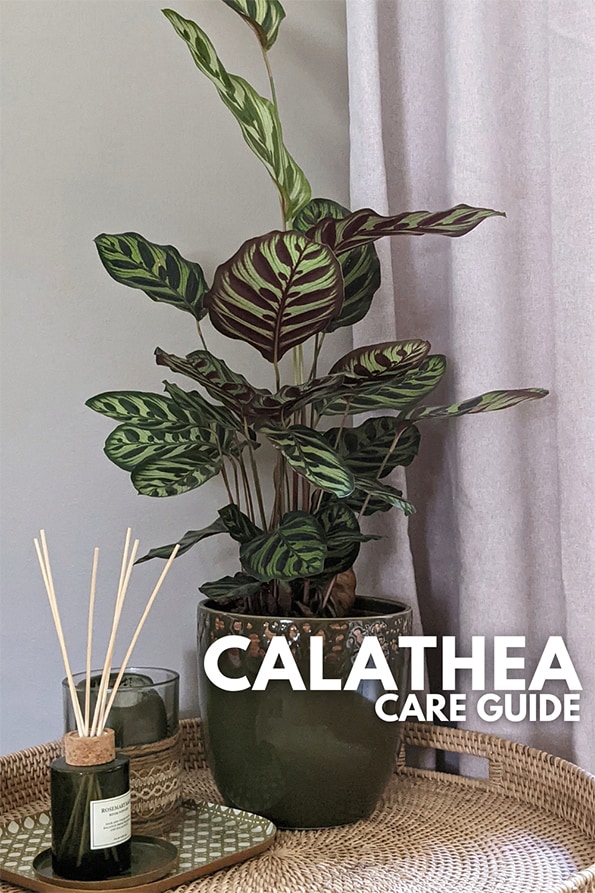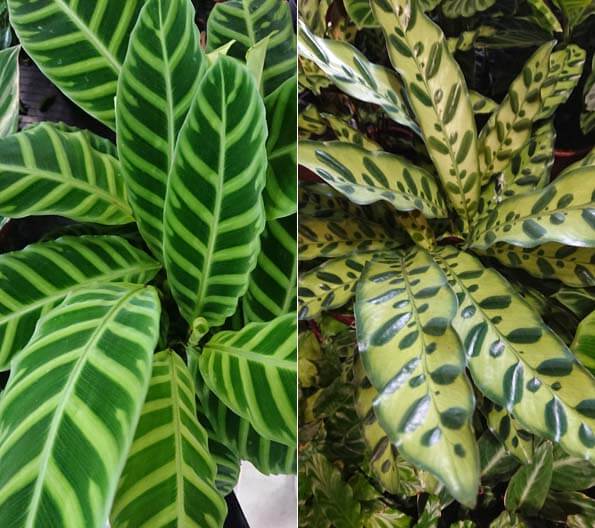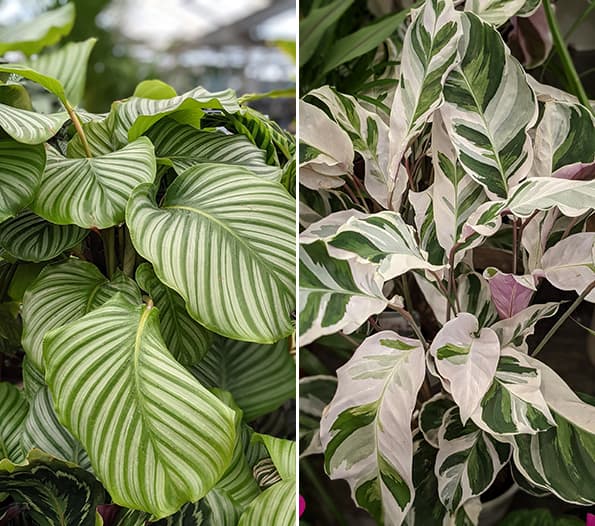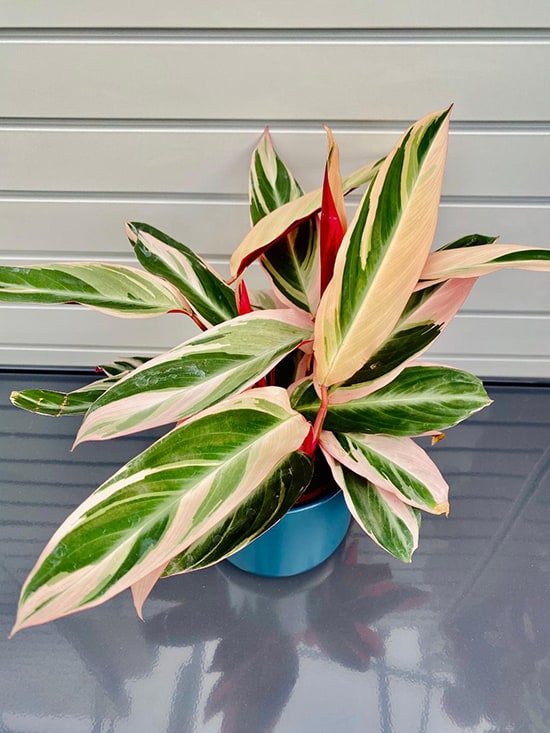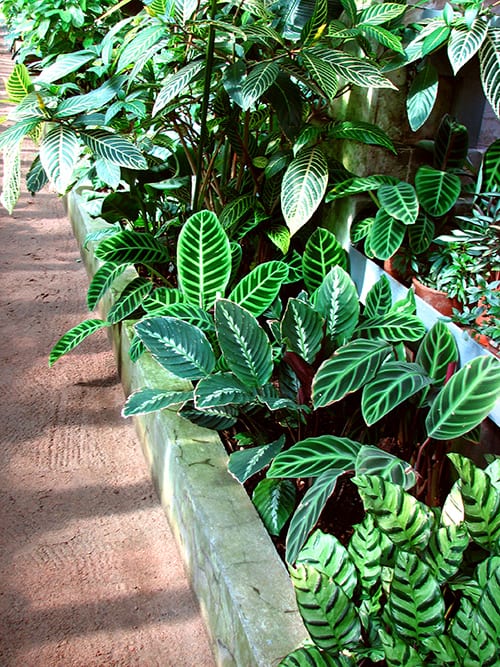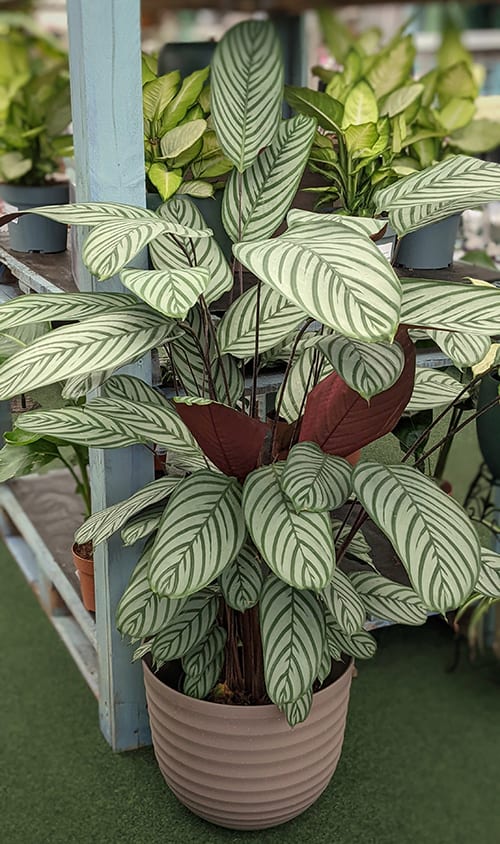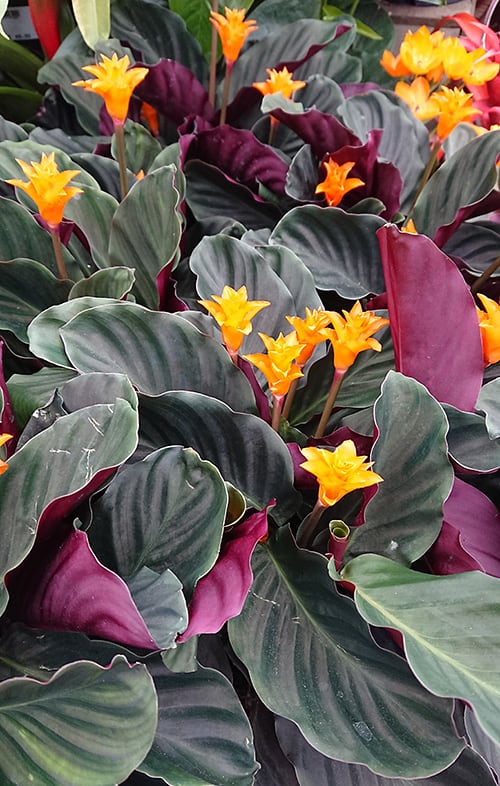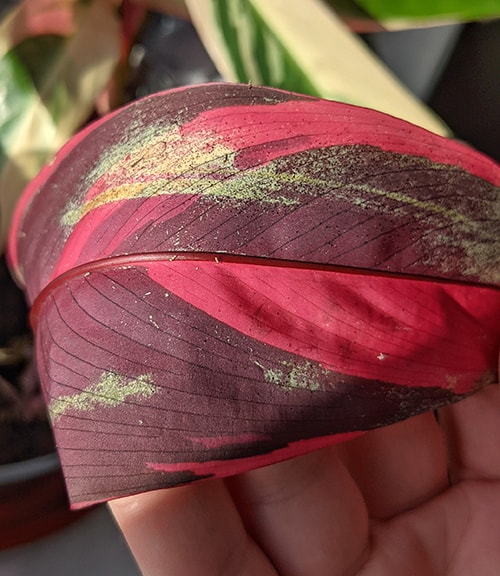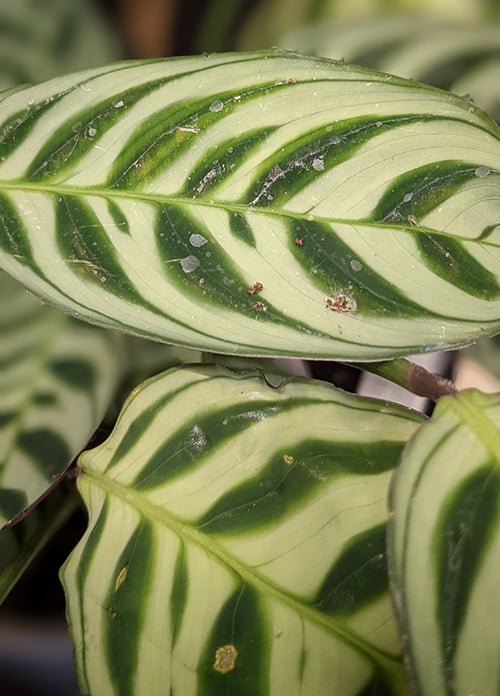When Calathea is grown as a houseplant, it sometimes goes by the common name Peacock Plant, Zebra Plant or Rattlesnake Plant. This is because of its stunning leaf markings, but it's much more common to know it by its Latin name, "Calathea".
Several houseplants are grown exclusively for their foliage, and the Calathea is one of these. The leaves and plants themselves come in many shapes and sizes, each one will typically have gorgeous looking ornately patterned leaves.
The markings on these tropical plants look almost artificial or painted on by a talented artist.
They can be tricky indoor plants to keep and the care needs are pretty specific. If you can't deliver what they need, they won't look good for long.
How do you pronounce Calathea correctly? Say:
Cah-Leef-thee-UH
The common names it goes by reflect the unusual and stunning leaves. Occasionally you may find it labeled as a "Prayer Plant" because of how it folds up its leaves at night.
But this naming is potentially a mislabel as the "Prayer Plant" is strictly a Maranta and therefore belongs to the Marantaceae family. Although (and we promise it won't get any more complicated than this) the Marantaceae family includes the Calathea genus.
It also includes the Goeppertia genus, Ctenanthe genus and Stromanthe genus which also look very like Calathea plants too!
Why does Calathea fold up at night?
Most Calathea plants will fold up their leaves (at least a little bit) when they sense it's getting dark. This is known as nyctinasty.
The reasons the plant does it are uncertain. But it's thought it could help protect the plants from being eaten, repeals pests, protects the plant from cold temperatures, and helps direct any rainfall down to the roots.
So basically, Calathea, Maranta, Ctenanthe, Stromanthe, and Goeppertia plants are all closely related. They look very similar and essentially have the same care requirements.
The leaves tend to stand stiffly away from the main plant and if you're attentive, you'll notice that they change position slightly during the day in response to changes in temperature and humidity or moisture requirements.
If treated properly, they'll produce large leaves and grow into reasonably large houseplants. This means they won't be long-term guests on small window shelves, but arguably they look best when looking down at them from above anyway.
All that beauty comes with a trade-off, however, and that is in the care requirements. This is not an easy houseplant to keep if you don't have the right environment or treat it poorly.
If you're inexperienced or prefer low maintenance house guests, you might want to try something else first. Either way, they can definitely live indoors for many years - check out our readers comments for their success stories and beautiful photos.
This is a houseplant that is not grown for its flowers (which tend to be rare indoors anyway). That is true for all Calathea except for C. crocata otherwise known as the "Flowering Calathea".
Within the last 10 years, this variety has become popular and desired. The leaves are quite dull compared to other Calatheas, but the unique, large number of orange flowers often makes it worth considering. There is a photo of it in our gallery.
If you plan to stick with the foliage as the focus then look out for C. makoyana, C. insignis, C. leopardina, C. zebrina and C. lancifolia. The last two are shown in the photo below and the others can be seen in our photo gallery.
The plant on the left is Calathea zebrina, and on the right, you're looking at Calathea lancifolia.
If you're after something a little rarer or extra special, then there are three I'd recommend. The first is C. orbifolia with massive stripped leaves that look like Zebra Strikes. It's a standout plant and looks good in many homes.
C. lietzei "Fusion White", can be fairly expensive, but its leaves are incredible looking and large splashes of white. Although it's slow growing, they still look fantastic when small, and it means you can have it on a window sill or tabletop without it taking up too much space.
On the Left is a Calathea orbifolia and on the right is Calathea lietzei "Fusion White".
I'd also vouch for the third and final plant, Calathea 'Triostar'. It's not actually a Calathea, but it is a plant from the Stromanthe genus (still part of the family, though!), so closely related and has the same care requirements.
People might disagree but I found Triostar to be a little easier in terms of care. This is a good thing, because it's a true showstopper, with rich, bold and varied leaf patterns and a lovely hue of pink on the underside of every leaf. It's a plant many people want to own.
Calathea 'Triostar' or Triostar Stromanthe is a very colorful and bright foliage houseplant.

Hi, I'm Tom!
If you're like me and enjoy the challenge of growing houseplants and getting them to thrive, then Ourhouseplants can help. This website shares my knowledge and years of growing plants and provides (hopefully) helpful advice on properly caring for your indoor plant friends.
No direct sunlight for your Calathea plant, otherwise you will lose the markings. On the other hand, very dark spots need to be given a miss as well.
A North facing windowsill would be the first choice here, but any other situation will be acceptable, providing you can provide shielding from the direct sunlight these places would receive at some point during the day. For example a south facing window that is heavily shaded by a tree would be ideal.
Markings can become more vivid or lost entirely if the lighting is wrong. Observe your plant and move it, if it looks less vibrant than usual.
For a Calathea to thrive as a houseplant, high humidity, warm temperatures and regular watering is needed.
People often come unstuck with the Calathea when it comes to its watering requirements and here's why:
This plant demands to be slightly moist or "damp" almost always but never "wet" or sitting in water.
This means regular small amounts of water during the growing seasons as soon as the surface dries up. However, the plant will let you off and accept less water when things turn cooler and darker as Winter approaches and takes hold.
A free draining potting mix, with at least one drainage hole (along with somewhere it can escape from), will help loads in preventing root rot caused by excessive overwatering.
Like your watering approach, humidity is really important for a healthy and attractive looking Calathea. They all require high humidity (or high-ish) and failure to provide this is one of the main causes of failure.
Young or naturally small varieties would be excellent choices for a Bottle Garden as they have a naturally high humid environment.
For Calathea to thrive as an indoor plant, high humidity, temperatures and lots of water is needed - Photo by Andrey Korzun
If this isn't an option, you must find other ways to increase humidity. Regular misting of the leaves, is not an effective long term solution for plants growing in very arid places. Addtionally, with Calathea plants in particular, misting in hard water areas will leave water marks when the water evaporates.
Grouping them or sitting the pots on pebble trays are options too. As is a proper humidifier.
If you are serious about keeping this plant indoors and struggling to keep the humidity high, read of our humidity article for some pointers.
If you have a plant that's a year or so old and growing well, feed it every fortnight during the growing seasons (Spring, Summer) with a half strength proprietary houseplant fertilizer. None in Winter.
Healthy and vigorous plants will come from warm to high temperatures with good natural ventilation but without any strong draughts.
Aim for a temperature range between 15°C (60°F) - 23°C (74°F) all year round (the upper range is better). Never lower than 15°C (59°F).
If your plant is growing well, look to repot every other year during Spring or Summer into fresh potting soil.
If you want to propagate your Calathea (see below) you can do this at repotting time, although the overall "bushy" look will be drastically changed.
Propagating a large Calathea is quite easy by division. All the leaves rise from a central rootstock and in time a clump of these roots will form and spread out slightly from the center.
All you need to do is gently divide the plant in half (or even smaller pieces if you have a huge plant to start with) and pot each new section into its own pot. Try to make sure each section has some of the original roots.
Then all you have to do is keep the divisions shady, warm and moist by covering the pots and new plants with plastic. Once you can see new growth starting (usually within a month) remove the plastic and grow as normal.
This Ctenanthe is one houseplant that really does deserve to have its beautiful foliage shown off.
These houseplants have a moderately fast growth rate, especially when grown in warmer temperatures.
Indoor Calathea plants can reach a good age and a large size with correct care. The Flowering Calathea will obtain a smaller size of 30cm / 12in (excluding the height of the flowers) or so whereas the others could easily be double that at 60cm / 2ft.
The majority of Calathea do not flower, or rather they do not flower indoors and this is because the conditions aren't suitable for them to do so.
The exception to this is C. crocata which is sold not because of its leaf markings or shape, but because it does indeed produce wonderful orange flowers that wave above the plant's basic foliage.
C. crocata will repeat flower if you maintain good growing conditions as instructed above.
Many Calathea species don't produce flowers indoors, but this one will every year if looked after well.
A few of our readers have had other Calathea plants other than C. crocata flower indoors. They've kindly shared their photos in the comments below if you're curious about what they look like.
A beautiful looking foliage plant that has the added bonus of not being poisonous to people or pets.
When the leaves get dusty (and they will), clean them with a damp cloth or wash the dirt off under a tepid shower. Do not use leaf shine products on these plants.
Crispy brown leaf edges and poor Calathea growth.
Brown edges can be caused by prolonged low humidity or leaving it too long between waterings.
These plants demand warm and semi humid conditions pretty much constantly. If you don't provide this, growth slows down and the leaves will quickly become tatty looking. Cut off the brown bits and improve its treatment going forward.
Leaves curling and spotted, with lower yellow leaves.
Too little water i.e. underwatering. The soil must be kept moist most of the time during the growing season.
The only time it will forgive you for this is during the Winter when it has stopped growing, if you let the soil dry out at any other time of the year these types of symptoms will appear.
Grainy dots, minor markings or something sticky under the leaves.
This is a pretty common issue actually. I've seen it on a lot of my plants over the years and it can have several causes.
Thrips on the undersides of the leaves. One of my top dreaded insect pests to have. Treat them quickly or they can destroy your plant and spread to others in your home.
White Crystals on Calathea Leaves.
Little white spots, that can be washed away but come back within a week or so on the back of the leaves are fairly common. It's similar to the problem above in some ways because the mess seems to cluster around the primary vein of the leaf, rather than all over or in random places.
It's caused by a natural process called Guttation, which is where the plant leaks excess water out of the leaves at night. It's common with many plants, but the difference is that Calathea will also expel salts and minerals along with this excess water, especially if using tap water. In contrast, many other houseplants don't put out quite as much.
When the water evaporates from the Calathea leaves, it leaves behind the salts and minerals, which appear as white grains that look like salt.
What do I do to prevent it?
Nothing. The leftover minerals are harmless. Additionally, they can't be seen unless you turn the leaf over, and can just be washed off every few months if there is a heavy buildup.
There is no real solution other than to water a little less or try and use more pure types of water, like filtered, rain or distilled water.
However this could be a hassle, might not prevent it entirely and ultimately more expensive to keep using more specialised types of water.
Limp, rotting stems or drooping leaves.
This could be a sign of overwatering, although it's more likely a sign of the temperature being too cold or from exposure to draughts.
The damage will not be reversible if this is prolonged. Move it to a warmer spot or away from the cold drafts immediately if you ever notice this happening.
Calathea leaf pattern fading / washed out appearance.
This will have been caused by one of two reasons - either too much light or not enough. In 90% of cases, it's due to exposure to direct sunlight. Find a new shadier home for your plant.
Marks on the leaves.
In most cases it's simply hard water. Quite common for shop brought or if you mist your plants. Hard water contains small amounts of minerals like lime, which when dried, will leave "watermarks" on the leaves. You can remove the worse of it by wiping down the entire leaf surface with a damp cloth.
This is a good reason not to mist the leaves. As well as potentially encouraging fungal diseases, it can also leave these white water marks.
Red Spider Mite.
If you have Red Spider Mites setting up a home, then your plants in real trouble. Red Spider Mites can be very hard to spot with the naked eye, but they spin their tell-tale cobwebs that immediately let you know what you're dealing with.
The reason your plant's in serious trouble is because these mites absolutely hate highly humid places whereas your plant needs this environmental condition to thrive in your home.
So if this pest turns up then your Calathea isn't being cared for properly and is likely already struggling. This means the Spider Mite attacks will be doing more damage than if they were attacking a healthy plant.
Check out our pest guide to help you get rid of this pest. Then return to this guide and read through our Calathea care instructions above for help to get your houseplant back on track.
Credit for C. zebrina and C. leopardina - Gallery photos by Forest & Kim Starr
Credit for C. lancifolia leaves - Gallery photo by Dinkum
